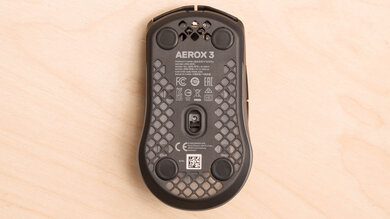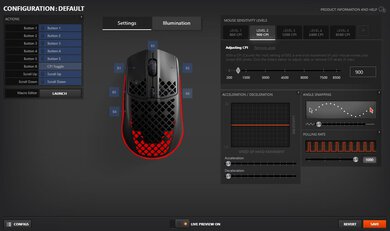The SteelSeries Aerox 3 is an excellent wired ultra-light gaming mouse. It has a lightweight honeycomb body that's nearly identical to the SteelSeries Aerox 3 Wireless, with the same ambidextrous shape that's best suited for a claw or fingertip grip. The PTFE feet are excellent and provide a smooth glide, but the cable is a bit stiff, albeit replaceable. It has a standard button layout with two thumb buttons on the left side, and they're all programmable through software, where you can also adjust performance settings and customize the three RGB lighting zones. It uses a different sensor than its wireless sibling as it has a narrower CPI range and a higher lift-off distance. Also, even though it has onboard memory, it doesn't let you save macros. This mouse has been replaced by the SteelSeries Aerox 3 (2022).
Our Verdict
The SteelSeries Aerox 3 is okay for office use. It has good build quality and is reasonably comfortable to use for long periods. It has a great number of programmable inputs and is fully compatible with both Windows and macOS. Unfortunately, it's a wired-only mouse, and the scroll wheel lacks infinite scrolling as well as L/R tilt inputs.
-
Very lightweight.
-
Programmable buttons.
-
Reasonably comfortable to use for extended periods.
-
No wireless connectivity.
-
No infinite scrolling or L/R tilt inputs.
-
No multi-device pairing.
-
Body flexes and creaks when applying pressure.
The SteelSeries Aerox 3 is great for FPS games. It's lightweight, and it has an ambidextrous shape that's reasonably comfortable to use. The build quality is good overall, but the body flexes when squeezed, and the cable is on the stiff side. It has low click latency and a high polling rate, and it performs consistently at the correct sensitivity setting. The lift-off distance is high, which might be an issue if you reposition the mouse a lot.
-
Very lightweight.
-
Very smooth glide.
-
Reasonably comfortable to use for extended periods.
-
Low click latency.
-
Body flexes and creaks when applying pressure.
-
High lift-off distance.
The SteelSeries Aerox 3 Wired is good for MMO games. It's well-built overall and fairly comfortable to use for extended periods. It has low click latency and a high polling rate; however, its lift-off distance is a bit high, which can cause unintended cursor movements to be registered when repositioning. There's a decent number of buttons, but it might not be enough for some MMO players.
-
Very lightweight.
-
Reasonably comfortable to use for extended periods.
-
Low click latency.
-
Might not have enough buttons for some MMO players.
-
Body flexes and creaks when applying pressure.
-
High lift-off distance.
The SteelSeries Aerox 3 is excellent for ultra-light gaming. It's lightweight, and its PTFE feet provide a very smooth glide. It has a high polling rate and low click latency to deliver a responsive gaming experience, but it has a high lift-off distance that might be an issue for those who reposition a lot. The cable is a bit stiff; however, it's detachable, so you can swap it out for another one that you like. While the build quality is good overall, there's still some flexing and creaking when squeezing the mouse.
-
Very lightweight.
-
Very smooth glide.
-
Reasonably comfortable to use for extended periods.
-
Low click latency.
-
Body flexes and creaks when applying pressure.
-
High lift-off distance.
The SteelSeries Aerox 3 is inadequate for portable use. It's wired-only, and it might not fit in some laptop cases. The build quality is good, but the body flexes and creaks when squeezed. It has onboard memory so that you can access your custom profiles on a computer that doesn't have the Engine 3 software installed; however, it doesn't allow you to save macros.
-
Very lightweight.
-
Reasonably comfortable to use for extended periods.
-
No wireless connectivity.
-
Might not fit in some laptop cases.
-
Body flexes and creaks when applying pressure.
- 6.9 Office/Multimedia
- 8.4 Video Games (FPS)
- 7.7 Video Games (MMO)
- 8.7 Ultra-Light Gaming
- 5.3 Travel
- Updated Jan 06, 2021: Review published.
- Updated Jan 04, 2021: Early access published.
- Updated Dec 21, 2020: Our testers have started testing this product.
- Updated Dec 17, 2020: The product has arrived in our lab, and our testers will start evaluating it soon.
- Updated Dec 05, 2020: We've purchased the product and are waiting for it to arrive in our lab.
Differences Between Sizes And Variants
The SteelSeries Aerox 3 is the wired version of the SteelSeries Aerox 3 Wireless; however, the wired version uses a different sensor that doesn't perform as well. There are no other variants, and it only comes in black. You can see our unit's label here.
Compared To Other Mice
The SteelSeries Aerox 3 Wired is an excellent mouse for ultra-light gaming. However, its lack of wireless connectivity makes it less ideal for office and portable use than its wireless sibling, the SteelSeries Aerox 3 Wireless. Also, it uses a different sensor that has a narrower CPI range and a higher lift-off distance. For more options, check out our recommendations for the best gaming mouse, the best wired mouse, and the best FPS mouse.
The SteelSeries Aerox 3 and the GLORIOUS Model O are very similar wired mice. They both have a lightweight, ambidextrous design with a right-handed button layout. The GLORIOUS has a better build quality, higher quality cable and feet, and its sensor has a wider sensitivity range and a lower lift-off distance. However, the SteelSeries is lighter, and it has more programmable inputs and software support for macOS. The GLORIOUS' slightly longer body makes it more suitable for large hands using a palm grip, but it also makes it less ideal for small hands using a claw or fingertip grip.
The SteelSeries Aerox 3 and the SteelSeries Aerox 5 are similar lightweight gaming mice that have identical click latency, but they're intended for different gaming genres. The Aerox 5 is a multi-genre mouse that feels better built, and its feet and cable are of higher quality. Also, it has a better sensor with a much lower lift-off distance, and it has more side buttons. On the other hand, the Aerox 3 is a lightweight, symmetrical mouse designed specifically for FPS games. Also, it's better suited for smaller hands.
The SteelSeries Aerox 3 and the Logitech G502 HERO are very different. The SteelSeries is better suited for ultra-light gaming and is significantly lighter due to its honeycomb body. The Logitech is better suited for MMOs because it has many more buttons. The Logitech has a right-handed ergonomic design that's more comfortable than the SteelSeries's ambidextrous shape. It has a wider CPI range, a lower lift-off distance, and lets you adjust the sensitivity in smaller increments. The Logitech has better build quality overall, but the SteelSeries has higher quality feet.
The SteelSeries Aerox 3 and the Razer DeathAdder V2 are very different mice. While they're both designed for right-handed use, the Razer's ergonomic shape is more comfortable than the SteelSeries' ambidextrous design. The SteelSeries is lighter due to its honeycomb body but doesn't feel as well-built as the Razer. The Razer has more buttons, as well as higher quality cable and feet. It also has a wider CPI range, a lower lift-off distance, and it lets you adjust the sensitivity in smaller increments. On the other hand, the SteelSeries has software support for macOS, while the Razer doesn't.
The SteelSeries Aerox 3 (2022) is an upgraded version of the SteelSeries Aerox 3. They look identical, but the 2022 edition has better quality mouse feet that are larger and extend over the width of the mouse instead of being just four small circles on each corner. Otherwise, they have the same sensor, same high lift-off distance, and nearly identical amounts of click latency. Both mice are advertised as rated at IP54, including all of their components, which is a high rating for a gaming mouse.
The SteelSeries Aerox 3 is the wired version of the SteelSeries Aerox 3 Wireless; however, it has a different sensor than its wireless counterpart. The Wireless has a much wider CPI range, and its lower lift-off distance leads to fewer unintended movements when repositioning the mouse. Also, it's only slightly heavier than the wired version despite having an internal battery. Its wireless connectivity and multi-device pairing feature make it more ideal for office and portable use. The Wired has lower click latency and better build quality.
The Cooler Master MM720 and the SteelSeries Aerox 3 are similar wired mice with a lightweight honeycomb body and a standard right-handed button layout. The Cooler Master is much lighter, and its ergonomic shape is more comfortable, but it might not be to everyone's liking, in which case, the SteelSeries' ambidextrous shape might be a better choice. The Cooler Master's cable and feet are of higher quality, and its sensor has a wide CPI range and lower lift-off distance. The SteelSeries has a better build quality and is fully compatible with macOS, which the Cooler Master isn't.
The SteelSeries Aerox 3 and the G-Wolves Hati HT-M Classic Edition are very much alike. They're both wired mice with an ambidextrous design and a right-handed button layout. However, the G-Wolves' slightly longer body and taller back make it more comfortable for those with large hands using a palm grip. The G-Wolves is lighter and has a higher-quality cable, but its feet aren't as smooth as the SteelSeries'. It also has a wider sensitivity range and a lower lift-off distance. The SteelSeries has more programmable inputs and software support for macOS.
The SteelSeries Aerox 3 and the HK Gaming Mira-M are both excellent lightweight gaming mice. The SteelSeries is marginally lighter and has a lower click latency. It also has customization software compatible with Windows and macOS, while the HK Gaming software is only compatible with Windows. The HK Gaming feels sturdier, it has a more flexible cable, and its mouse feet glide more smoothly. It also has a wider CPI range and a lower lift-off distance. Both mice are well-suited for all grip types and most hand sizes, but the HK Gaming is more accommodating for more hand sizes.
Test Results
The SteelSeries Aerox 3 is the wired version of the SteelSeries Aerox 3 Wireless and is almost identical in design. It has a lightweight honeycomb body with a matte black finish. There are three independent RGB lighting zones you can customize through the SteelSeries Engine 3 software.
This mouse is very light. It's lighter than its wireless sibling, the SteelSeries Aerox 3 Wireless, since it doesn't need an internal battery. Unfortunately, there's no weight optimization. If you're interested in a similar gaming mouse that's even lighter, check out the G-Wolves Hati HT-S ACE Edition.
The build quality is good overall. However, there's some flex and creaking when pressure is applied on the body, and the scroll wheel has a slight rattle. The flex on the underside can cause the CPI button to activate, but it shouldn't be an issue in normal use. It's advertised to have an IP54 dust and water resistance rating, but this isn't something we test for. If you're looking for a similar mouse with a more robust-feeling build quality, check out the XTRFY M42 or the Cooler Master MM711.
This mouse has an ambidextrous shape but with thumb buttons on the left side only, making it more ideal for right-handed use. It's reasonably comfortable to use for an extended period and best suited for a fingertip or claw grip. There are no side grips. If you'd prefer a wired FPS gaming mouse with comparable performance but a right-handed shape, check out the BenQ ZOWIE EC1.
This is a wired-only mouse. If you want the wireless version, check out the SteelSeries Aerox 3 Wireless.
The cable is decent and the same one as the SteelSeries Aerox 3 Wireless. It feels like a mix of a braided and paracord-like cable. It isn't very flexible and retains kinks, but it's detachable, so you can change it for your preferred cable. If you're looking for an ultra-lightweight gaming mouse with a cable that feels significantly lighter and more flexible, check out the XTRFY MZ1 – Zy’s Rail.
The PTFE feet are excellent. They're a bit thin, but they provide a very smooth glide whether you're on a cloth mouse pad or a harder surface like a desk. We can't find any third-party replacement feet at this time. If you find some, please let us know in the discussions. It's replacement, the SteelSeries Aerox 3 (2022), has larger and better quality feet.
Unlike its wireless sibling, the SteelSeries Aerox 3 Wireless, the wired SteelSeries Aerox 3 uses a different optical sensor with a narrower CPI range. While it's more than enough for most people, its 100 CPI adjustment steps might disappoint those who want finer control. It also has a higher lift-off distance which may cause unwanted movements to be registered when repositioning the mouse. You can set the polling rate to 125Hz, 250Hz, 500Hz, or 1000Hz. If you want a similar model with a lower lift-off distance, check out the DELUX M700 or the DREVO Falcon Wireless RGB.
There are a decent number of buttons, and they're all programmable, including the scroll wheel's up and down scroll. You can reassign the left-click without first assigning it to another button, but you need another mouse to set it back to default since you won't have access to a left-click. There's a pop-up message that warns you before proceeding with the reassignment. However, if you're looking for a mouse with more side buttons to program, check out the SteelSeries Aerox 5.
The mouse wheel is fairly basic. It has a very low profile with soft and quiet increments. Unfortunately, there's no infinite scrolling or L/R tilt inputs, making it less ideal for office use.
This mouse has quiet clicking noise and shouldn't bother those around you.
The click latency is great. It's slightly higher than other ultra-light wired mice, such as the Razer Viper Mini or the Cooler Master MM720, but it shouldn't be noticeable for most people.
The SteelSeries Engine software has an exceptional number of features for customization. You can adjust the performance settings, create macros, and customize the RGB lighting. It isn't particularly user-friendly, so it may feel a bit overwhelming for those who aren't familiar with the software. You can save button remaps and custom lighting profiles on the onboard memory, but not macros.













